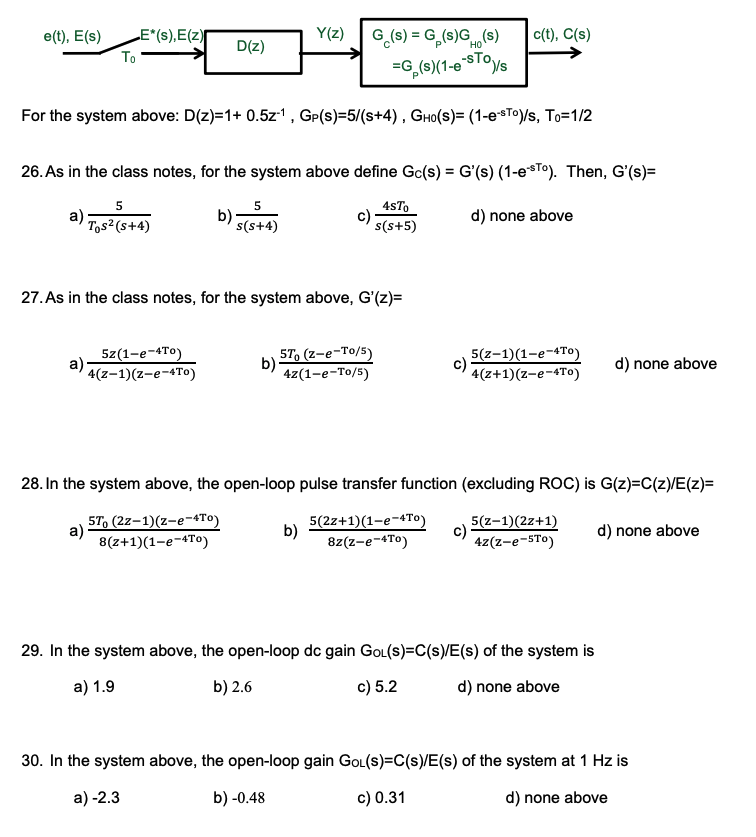e(t), E(s) LE*(s),E(z) Y(z) G (s) = G,(s)GH(s) c(t), C(s) D(z) To =G,(s)(1-0STOVS For the system above: D(z)=1+ 0.5z1, GP(s)=5/(s+4), GHO(S)= (1-e*T0)/s, To=1/2 26. As in the class notes, for the system above define Gc(s) = G'(s) (1-esTO). Then, G'(s)= a) Tos?(s+4) b) s(s+4) 4sTo c) s(s+5) d) none above 27. As in the class notes, for the system above, G'(z)= 5z(1-e-4To) a)· 4(z-1)(z-e-4To) 5T, (z-e-To/5) b) 4z(1-e-To/5) 5(z-1)(1-e-4To) 4(z+1)(z-e-4To) d) none above 28. In the system above, the open-loop pulse transfer function (excluding ROC) is G(z)=C(z)/E(z)= 57, (2z-1)(z-e-4TO) a) 8(z+1)(1-e-4To) 5(2z+1)(1-e-4To) b) 8z(z-e-4To) 5(z-1)(2z+1) c) 4z(z-e-STo) d) none above 29. In the system above, the open-loop dc gain GOL(s)=C(s)/E(s) of the system is a) 1.9 b) 2.6 c) 5.2 d) none above 30. In the system above, the open-loop gain GOL(s)=C(s)/E(s) of the system at 1 Hz is a) -2.3 b) -0.48 c) 0.31 d) none above
e(t), E(s) LE*(s),E(z) Y(z) G (s) = G,(s)GH(s) c(t), C(s) D(z) To =G,(s)(1-0STOVS For the system above: D(z)=1+ 0.5z1, GP(s)=5/(s+4), GHO(S)= (1-e*T0)/s, To=1/2 26. As in the class notes, for the system above define Gc(s) = G'(s) (1-esTO). Then, G'(s)= a) Tos?(s+4) b) s(s+4) 4sTo c) s(s+5) d) none above 27. As in the class notes, for the system above, G'(z)= 5z(1-e-4To) a)· 4(z-1)(z-e-4To) 5T, (z-e-To/5) b) 4z(1-e-To/5) 5(z-1)(1-e-4To) 4(z+1)(z-e-4To) d) none above 28. In the system above, the open-loop pulse transfer function (excluding ROC) is G(z)=C(z)/E(z)= 57, (2z-1)(z-e-4TO) a) 8(z+1)(1-e-4To) 5(2z+1)(1-e-4To) b) 8z(z-e-4To) 5(z-1)(2z+1) c) 4z(z-e-STo) d) none above 29. In the system above, the open-loop dc gain GOL(s)=C(s)/E(s) of the system is a) 1.9 b) 2.6 c) 5.2 d) none above 30. In the system above, the open-loop gain GOL(s)=C(s)/E(s) of the system at 1 Hz is a) -2.3 b) -0.48 c) 0.31 d) none above
Introductory Circuit Analysis (13th Edition)
13th Edition
ISBN:9780133923605
Author:Robert L. Boylestad
Publisher:Robert L. Boylestad
Chapter1: Introduction
Section: Chapter Questions
Problem 1P: Visit your local library (at school or home) and describe the extent to which it provides literature...
Related questions
Question

Transcribed Image Text:e(t), E(s)
LE*(s),E(z)
Y(z)
G (s) = G,(s)GH(s)
c(t), C(s)
D(z)
To
=G,(s)(1-0STOVS
For the system above: D(z)=1+ 0.5z1, GP(s)=5/(s+4), GHO(S)= (1-e*T0)/s, To=1/2
26. As in the class notes, for the system above define Gc(s) = G'(s) (1-esTO). Then, G'(s)=
a)
Tos?(s+4)
b)
s(s+4)
4sTo
c)
s(s+5)
d) none above
27. As in the class notes, for the system above, G'(z)=
5z(1-e-4To)
a)·
4(z-1)(z-e-4To)
5T, (z-e-To/5)
b)
4z(1-e-To/5)
5(z-1)(1-e-4To)
4(z+1)(z-e-4To)
d) none above
28. In the system above, the open-loop pulse transfer function (excluding ROC) is G(z)=C(z)/E(z)=
57, (2z-1)(z-e-4TO)
a)
8(z+1)(1-e-4To)
5(2z+1)(1-e-4To)
b)
8z(z-e-4To)
5(z-1)(2z+1)
c)
4z(z-e-STo)
d) none above
29. In the system above, the open-loop dc gain GOL(s)=C(s)/E(s) of the system is
a) 1.9
b) 2.6
c) 5.2
d) none above
30. In the system above, the open-loop gain GOL(s)=C(s)/E(s) of the system at 1 Hz is
a) -2.3
b) -0.48
c) 0.31
d) none above
Expert Solution
This question has been solved!
Explore an expertly crafted, step-by-step solution for a thorough understanding of key concepts.
This is a popular solution!
Trending now
This is a popular solution!
Step by step
Solved in 2 steps with 4 images

Recommended textbooks for you

Introductory Circuit Analysis (13th Edition)
Electrical Engineering
ISBN:
9780133923605
Author:
Robert L. Boylestad
Publisher:
PEARSON

Delmar's Standard Textbook Of Electricity
Electrical Engineering
ISBN:
9781337900348
Author:
Stephen L. Herman
Publisher:
Cengage Learning

Programmable Logic Controllers
Electrical Engineering
ISBN:
9780073373843
Author:
Frank D. Petruzella
Publisher:
McGraw-Hill Education

Introductory Circuit Analysis (13th Edition)
Electrical Engineering
ISBN:
9780133923605
Author:
Robert L. Boylestad
Publisher:
PEARSON

Delmar's Standard Textbook Of Electricity
Electrical Engineering
ISBN:
9781337900348
Author:
Stephen L. Herman
Publisher:
Cengage Learning

Programmable Logic Controllers
Electrical Engineering
ISBN:
9780073373843
Author:
Frank D. Petruzella
Publisher:
McGraw-Hill Education

Fundamentals of Electric Circuits
Electrical Engineering
ISBN:
9780078028229
Author:
Charles K Alexander, Matthew Sadiku
Publisher:
McGraw-Hill Education

Electric Circuits. (11th Edition)
Electrical Engineering
ISBN:
9780134746968
Author:
James W. Nilsson, Susan Riedel
Publisher:
PEARSON

Engineering Electromagnetics
Electrical Engineering
ISBN:
9780078028151
Author:
Hayt, William H. (william Hart), Jr, BUCK, John A.
Publisher:
Mcgraw-hill Education,